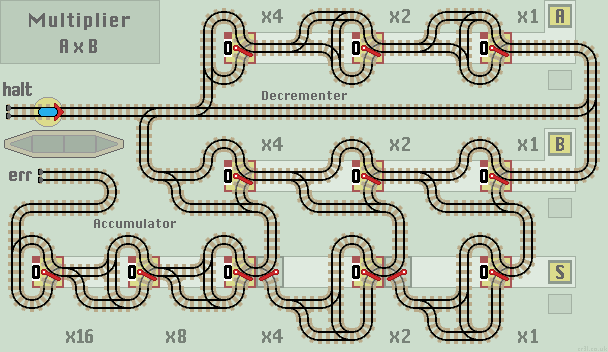Multiply AxB
This layout multiplies two binary numbers, held in input registers A and B, and outputs the result in register S. The calculation is performed by a series of additions.
Two functions are used:
- Count Down function to decrement A.
- Accumulator function, to add B into S.
Operation
Clear register S. Enter binary values for A and B (eg 3x5) and start the train from the station. When the train returns and halts, the result of AxB can be read from the output register S.

|
| Click layout to pause/run train | Click points to switch 0/1 | Click start circle to reset train/points |
| Lazy points switch between upper 0 or lower 1 branch lines Trains arriving on a branch line switch the point to that line |
|
| Sprung points allow branch line trains to join the main line All main line trains go straight ahead and never 'branch off' |
Notes
- If the result of A x B exceeds 31, register S overflows and the train returns to the lower station platform as an error. This should not happen unless dividing by zero. This can be prevented, see 'with swop' below.
- Register A is checked first. If it is 0, the train returns to the station and the calculation halts.
- The original value of A is 'lost' as the register counts down. A Copy function can be added to preserve the initial value of A.
- Multiplication is commutative, so AxB = BxA. A quicker calculation is obtained if the shorter number is entered into the A register. Calculating 1x15 is quick but 15x1 is slow.
Multiply AxB (with swop)
When multiplying say 7x2, the above layout performs seven additions of 2 to the Accumulator. With larger registers this can be very slow. To improve efficiency, the value of A and B is first compared. If A is less than B, the two values are swopped.
Two additional functions are used:
- Comparator function to compare A and B.
- Exchange function, to swop A and B.
The Decrementor counts down the value of A. By swopping A and B so that A is the smaller value improves efficiency. The maximum number of loop iterations is limited to the square root of the length of S. So for this layout it is 5. A sixth iteration will cause S to overflow.

|
| Click layout to pause/run train | Click points to switch 0/1 | Click start circle to reset train/points |
| Lazy points switch between upper 0 or lower 1 branch lines Trains arriving on a branch line switch the point to that line |
|
| Sprung points allow branch line trains to join the main line All main line trains go straight ahead and never 'branch off' |
Here is a non-interactive image of a possible computer layout of the above circuit.
Also see Multiplier using a shift register.